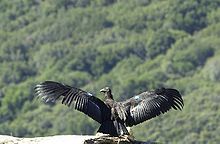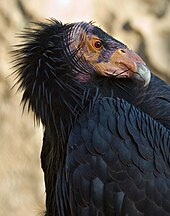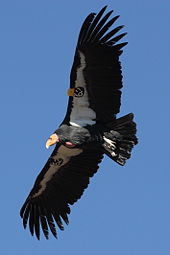
The California Condor (Gymnogyps californianus) is a New World vulture, the largest North American land bird. This condor inhabits northern Arizona and southern Utah (including the Grand Canyon area and Zion National Park), coastal mountains of central and southern California, and northern Baja California. Although other fossil members are known, it is the only surviving member of the genus Gymnogyps.
The plumage is black with patches of white on the underside of the wings and the head is largely bald, with skin color ranging from gray on young birds to yellow and bright orange on breeding adults. Its huge 3.0 meter/9.8 Feet wingspan is the largest of any North American bird, and its weight of up to 26 lbs. makes it the heaviest bird native to North America. Only the Trumpeter Swan has a comparable weight among native North American birds. The condor is a scavenger and eats large amounts of carrion. It is one of the world's longest-living birds, with a lifespan of up to 60 years.
Condor numbers dramatically declined in the 20th century due to poaching, lead poisoning, and habitat destruction. A conservation plan was put in place by the United States government that led to the capture of all 22 remaining wild condors in 1987. These surviving birds were bred at the San Diego Zoo Safari Park and the Los Angeles Zoo. Numbers rose through captive breeding and, beginning in 1991, condors have been reintroduced into the wild. The project is the most expensive species conservation project ever undertaken in the United States. The California Condor is one of the world's rarest bird species: as of December 2011, there are 390 condors known to be living, including 210 in the wild. The condor is a significant bird to many Californian Native American groups and plays an important role in several of their traditional myths.
Taxonomy
The California Condor was described by English naturalist George Shaw in 1797 as Vultur californianus. It was originally classified in the same genus as the Andean Condor (V. gryphus), but, due to the Andean Condor's slightly different markings, slightly longer wings, and tendency to kill small animals to eat, the California Condor has now been placed in its own monotypic genus. The generic name Gymnogyps is derived from the Greek gymnos/γυμνος "naked" or "bare", and gyps/γυψ "vulture", while the specific name californianus comes from its location in California. The word condor itself is derived from the Ecuadorian Quechua cuntur.The exact taxonomic placement of the California Condor and the other six species of New World vultures remains unclear. Though similar in appearance and ecological roles to Old World vultures, the New World vultures evolved from a different ancestor in a different part of the world. Just how different the two are is currently under debate, with some earlier authorities suggesting that the New World vultures are more closely related to storks. More recent authorities maintain their overall position in the order Falconiformes along with the Old World vultures or place them in their own order, Cathartiformes. The South American Classification Committee has removed the New World vultures from Ciconiiformes and instead placed them in Incertae sedis, but notes that a move to Falconiformes or Cathartiformes is possible.
Evolutionary history

Fossil of the extinct species Gymnogyps amplus from the La Brea Tar Pits
Today's California Condor is the sole surviving member of Gymnogyps and has no accepted subspecies; although its range greatly contracted during the Holocene, the species always had a small and inbred population. However, there is a Late Pleistocene form that is sometimes regarded as a palaeosubspecies, Gymnogyps californianus amplus. Current opinions are mixed regarding the classification of the form as a chronospecies or a separate species Gymnogyps amplus. Gymnogyps amplus occurred over much of the bird's historical range – even extending into Florida – but was larger, having about the same weight as the Andean Condor. This bird also had a wider bill. As the climate changed during the last ice age, the entire population became smaller until it had evolved into the Gymnogyps californianus californianus of today.
Description

Juvenile

Upper body
As an adaptation for hygiene, the condor's head and neck have few feathers, which exposes the skin to the sterilizing effects of dehydration and solar ultraviolet light at high altitudes. The skin of the head and neck is capable of flushing noticeably in response to emotional state, a capability that can serve as communication between individuals. The skin color varies from yellowish to a glowing reddish-orange.
Contrary to the usual rule among true birds of prey, the female is slightly smaller than the male. Overall length can range from 109–140 cm (43–55 in) and the wingspan is 2.49–3 m (8.2–9.8 ft). Their weight can range from 7–14.1 kg (15–31 lb), with estimations of average weight ranging from 8–9 kg (18–20 lb). Wingspans of up to 3.4 m (11 ft) have been reported but no wingspan over 3 m (9.8 ft) has been verified. Most measurements are from birds raised in captivity, so determining if there are any major differences in measurements between wild and captive condors is difficult.
California Condors have the largest wingspan of any North American bird. They are surpassed in both body length and weight only by the Trumpeter Swan and the introduced Mute Swan. The American White Pelican and Whooping Crane also have longer bodies than the condor. Condors are so large that they can be mistaken for a small, distant airplane, which possibly occurs more often than they are mistaken for other species of bird.
The middle toe of the California Condor's foot is greatly elongated, and the hind one is only slightly developed. The talons of all the toes are straight and blunt, and are thus more adapted to walking than gripping. This is more similar to their supposed relatives the storks than to birds of prey and Old World vultures, which use their feet as weapons or organs of prehension.
Historic range

California Oak savanna on the east flank of Sonoma Mountain
Habitat
The condors live in rocky scrubland, coniferous forests, and oak savannas. They are often found near cliffs or large trees, which they use as nesting sites. Individual birds have a huge range and have been known to travel up to 250 km (150 mi) in search of carrion.There are two sanctuaries dedicated to this bird, the Sisquoc Condor Sanctuary in the San Rafael Wilderness and the Sespe Condor Sanctuary in the Los Padres National Forest. These areas were chosen because of their prime condor nesting habitat.
Ecology and behavior

Adult in flight. Tracking tags can be seen on both wings.
The California Condor has a long life span, reaching up to 60 years.If it survives to adulthood, the condor has few natural threats other than humans. Their vocal display is limited to grunts and hisses. Condors bathe frequently and can spend hours a day preening their feathers. Condors also perform urohidrosis, or defecate on their legs, to reduce their body temperature. There is a well-developed social structure within large groups of condors, with competition to determine a pecking order decided by body language, competitive play behavior, and a variety of hisses and grunts. This social hierarchy is displayed especially when the birds feed, with the dominant birds eating before the younger ones.
Diet
Wild condors inhabit large territories, often traveling 250 km (160 mi) a day in search of carrion. It is thought that in the early days of its existence as a species, the California Condor lived off the carcasses of the "megafauna", which are now extinct in North America. They still prefer to feast on large, terrestrial mammalian carcasses such as deer, goats, sheep, donkeys, horses, pigs, cougars, bears, or cattle. Alternatively, they may feed on the bodies of smaller mammals, such as rabbits or coyotes, aquatic mammals such as whales and California Sea Lions, or salmon. Bird and reptile carcasses are rarely eaten. Since they do not have a sense of smell, they spot these corpses by looking for other scavengers, like eagles and smaller vultures, the latter of which cannot rip through the tougher hides of these larger animals with the efficiency of the larger condor. They can usually intimidate other scavengers away from the carcass, with the exception of bears, which will ignore them, and Golden Eagles, which will fight a condor over a kill or a carcass. In the wild they are intermittent eaters, often going for between a few days to two weeks without eating, then gorging themselves on 1–1.5 kilograms (2.2–3.3 lb) of meat at once.Reproduction

An adult with a 30-day old chick
The eggs hatch after 53 to 60 days of incubation by both parents. Chicks are born with their eyes open and sometimes can take up to a week to hatch from their egg. The young are covered with a grayish down until they are almost as large as their parents. They are able to fly after five to six months, but continue to roost and forage with their parents until they are in their second year, at which point the parents typically turn their energies to a new nest. Ravens are the main predatory threat to condor eggs, while golden eagles and bears are potential predators of condor offspring.
Conservation

A juvenile in the Grand Canyon, with its numbered tag prominent.
Current status
In modern times, a wide variety of causes have contributed to the condor's decline. Its low clutch size (one young per nest), combined with a late age of sexual maturity, make the bird vulnerable to artificial population decline. Significant damage to the condor population is also attributed to poaching, especially for museum specimens, lead poisoning (from eating animals containing lead shot DDT poisoning, electric power lines, egg collecting, and habitat destruction. During the California Gold Rush, some condors were even kept as pets. The leading cause of mortality in nestling condors is the ingestion of trash that is fed to them by their parents.In addition to this, cattle ranchers who observed condors feeding on the dead young of their cattle assumed that the birds killed the cattle. This fallacy led to the condor's extinction in some parts of the western United States. This belief was so deeply ingrained that the reintroduction of condors to the Grand Canyon was challenged by some cattle ranchers, who mistakenly believed that the bird hunted calves and lambs.
Unanticipated deaths among recent condor populations occurred due to contact with Golden Eagles, power lines, wind turbines and other factors such as lead poisoning. Since 1994, captive-bred California Condors have been trained to avoid power lines and people. Since the implementation of this aversion conditioning program, the number of condor deaths due to power lines has greatly decreased. Lead poisoning due to fragmented lead bullets in large game waste is a particularly big problem for condors due to their extremely strong digestive juices; this lead waste is not as much of a problem for other avian scavengers such as the Turkey Vulture and Common Raven. This problem has been addressed in California by the Ridley-Tree Condor Preservation Act, a bill that went into effect July 1, 2008 that requires that hunters use non-lead bullets when hunting in the condor's range. Blood lead levels in Golden Eagles as well as Turkey Vultures has declined with the implementation of the Ridley-Tree Condor Preservation Act, demonstrating that the legislation has helped reduce other species' lead exposures aside from the California Condor.
California Condor Recovery Plan

Condor chick being fed by condor feeding puppet
The goal of the California Condor Recovery Plan was to establish two geographically separate populations, one in California and the other in Arizona, each with 150 birds and at least 15 breeding pairs. As the Recovery Program works toward this goal the number of release sites has grown. There are three active release sites in California, one in Arizona and one in Baja California, Mexico.
The captive breeding program, led by the San Diego Wild Animal Park and Los Angeles Zoo, got off to a slow start due to the condor's mating habits. However, utilizing the bird's ability to double clutch, biologists began removing the first egg from the nest and raising it with puppets, allowing the parents to lay another egg.
As the number of condors grew, attention began to focus on releasing some back into the wild. In 1988, the United States Fish and Wildlife Service began a reintroduction experiment involving the release of captive Andean Condors into the wild in California. Only females were released, to eliminate the possibility of accidentally introducing a South American species into the United States. The experiment was a success, and all the Andean Condors were recaptured and re-released in South America. California Condors were released in 1991 and 1992 in California, and again in 1996 in Arizona near the Grand Canyon. Though the birth rate remains low in the wild, their numbers are increasing steadily through regular releases of captive-reared adolescents.

A USFWS sign at Bitter Creek National Wildlife Refuge, California, USA
As the Recovery Program achieved milestones, a fifth active release site in Sierra de San Pedro Mártir National Park, Baja California, Mexico, was added to the three release sites in California (Big Sur, Pinnacles National Monument and Bitter Creek National Wildlife Refuge) and the Vermilion Cliffs release site in Arizona. In early 2007, a California Condor laid an egg in Mexico for the first time since at least the 1930s. The population of the condors has risen due to these wild and also captive nestings. In the spring of 2009, a second wild chick was born in the Sierra de San Pedro Mártir National Park and was named Inyaa ("Sun" in the Kiliwa language) by local environmentalists.
Relationship with humans

California Condor skull
The Wiyot tribe of California say that the condor recreated mankind after Above Old Man wiped humanity out with a flood. However, other tribes, such as California's Mono, viewed the condor as a destroyer, not a creator. They say that Condor seized humans, cut off their heads, and drained their blood so that it would flood Ground Squirrel's home. Condor then seized Ground Squirrel after he fled, but Ground Squirrel managed to cut off Condor's head when Condor paused to take a drink of the blood. According to the Yokut tribe, the condor sometimes ate the moon, causing the lunar cycle, and his wings caused eclipses. The Chumash tribe of Southern California believed that the condor was once a white bird, but it turned black when it flew too close to a fire.
Condor bones have been found in Native American graves, as have condor feather headdresses. Cave paintings of condors have also been discovered. Some tribes ritually killed condors to make ceremonial clothing out of their feathers. Shamans then danced while wearing these to reach the upper and lower spiritual worlds. Whenever a shaman died, his clothes were said to be cursed, so new clothing had to be made for his successor. Some scientists, such as Noel Snyder, believe that this process of making ceremonial clothing helped contribute to the condor's decline.

No comments:
Post a Comment